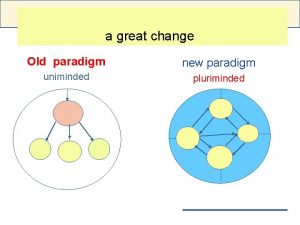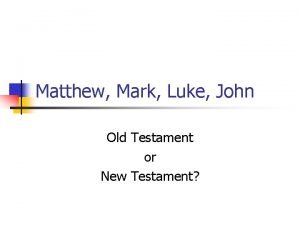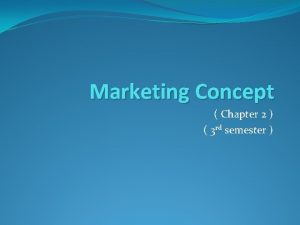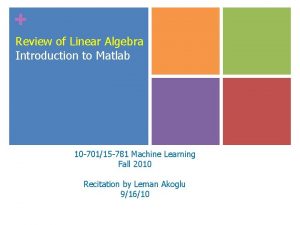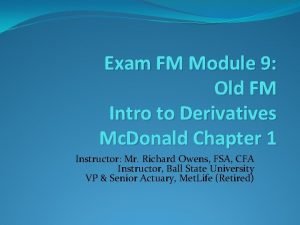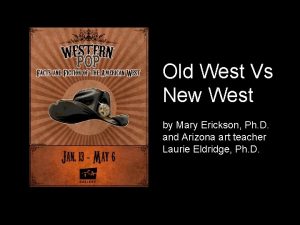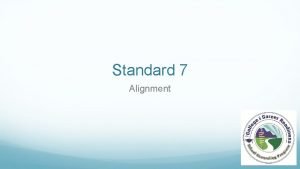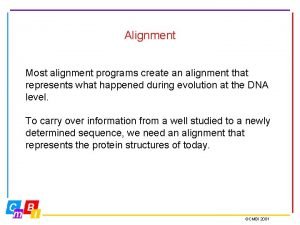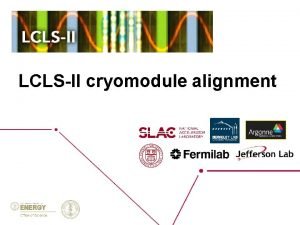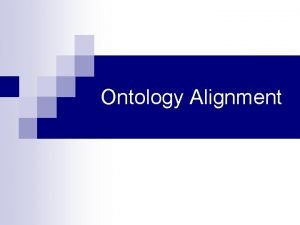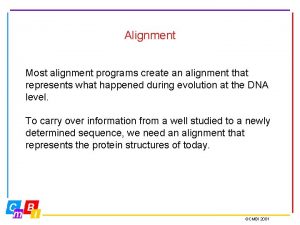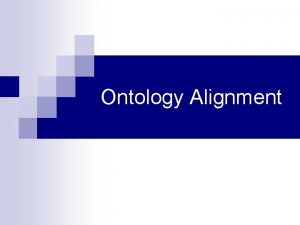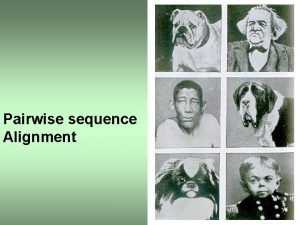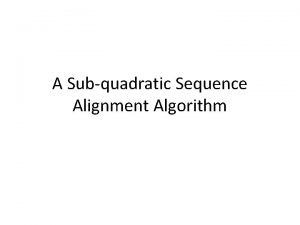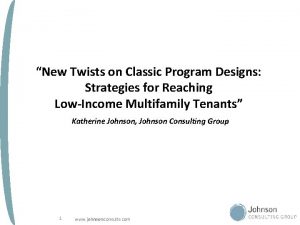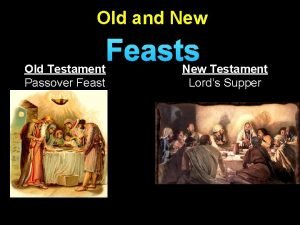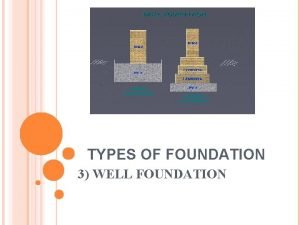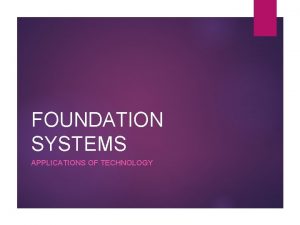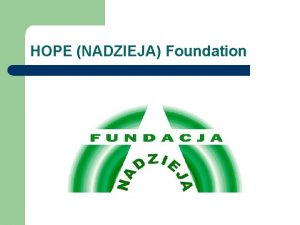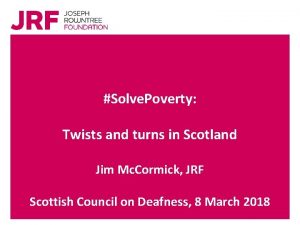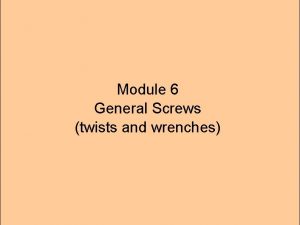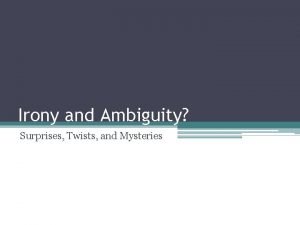Foundation of Alignment New Twists on an Old















































- Slides: 47

Foundation of Alignment – New Twists on an Old Theme Monday, June 22, 2015: 2: 00 PM-3: 30 PM Harbor F (Manchester Grand Hyatt San Diego)

Introductions & Agenda

Introductions • Kenji Hakuta Professor, Stanford University; Principal Investigator, ELPA 21; and Co-Director, Understanding Language Initiative, Stanford Graduate School of Education • Margaret Ho Program Director, ELPA 21, CCSSO • Doug Kosty Assistant Superintendent, Office of Learning, Oregon Department of Education • Emilie Pooler Assessment Designer, ETS Moderator • Robert Linquanti Project Director, EL Evaluation & Accountability Support & Senior Researcher, West. Ed

Agenda • ELPA 21 Overview • The State of a State • The ELP Standards • The ELPA 21 Assessment System • Design • Implementation • Professional Development

ELPA 21 Overview Alignment of standards, assessments, and professional development is necessary for student success

State Representation

Lead State Management Partner 3 Thought Partners Standards Authors Guidance and Feedback

Deliverables and Outcomes • We are in the unique position of integrating new standards, assessments, technology, and teacher and administrator supports — all leading toward better systems of support and learning for ELLs. • Summative Tests, K through 12 • Screener, K through 12 • Blind/Low Vision Forms, K through 12 • Professional Development Modules

Operational Timeline – Year 1, SY 2015 -16 Month September 2015 October 2015 Outcome To vendors: Final ELPA 21 Item Specifications; operational Item Bank To vendors: Assessment Framework (metadata, form planners) October – December 2015 Test administration platforms: Item reviews, UAT January – April 2016 May 2016 June 2016 Operational test administration Data Review, Rangefinding Standard Setting

The State of a State Alignment of standards, assessments, and professional development is necessary for student success

The State of a State: Oregon • Benefits of ELPA 21 Assessment System • Professional development & a new item bank • Computer-based testing is a big shift for most states • Screener • Standardized screener is new for ODE • Common definition of ELLs • Identified, supplemental supports, process, exiting • Longitudinal analysis • How ELLs succeeded and what happens years after into college and careers (Ever-ELL category)

Oregon’s ELL Population Number of ELL Students Statewide by Academic Year 80, 000 70, 000 66, 579 66, 785 67, 343 65, 943 62, 594 Number of Students 60, 000 58, 732 56, 954 50, 000 40, 000 30, 000 20, 000 10, 000 0 2007 2008 2009 2010 Academic Year 2011 2012 2013


Former and Current ELs in Oregon • About 20% of Oregon students are Ever ELLs, meaning they are current or former ELLs • ~ 10% of students are current ELL • ~ 10% of students former ELL • These percentages mirror the national percentages of current and former ELLs in the U. S. • About 75% of Oregon’s ELLs speak Spanish at home, similar to the national average

Outcomes for ELs in Oregon: Graduation • In 2012 -13, 49% of students classified as ELL graduated from high school within four years • Clearly, in order for ELLs to be ready for college and careers, there is an urgent need for changes to business as usual • At the same time, it is important to understand long-term outcomes for all students who enter schools as ELLs, including those who have attained English proficiency and exited ELL services. In 2012 -13: • 59% of Ever ELLs (both current and former ELLs) graduated within four years • 72% of former ELLs graduated within four years • 71% of students never classified as ELLs graduated within four years

Moving Toward Consistency • In the past, Oregon districts have had a choice of four different assessments to use for initial identification of ELLs • Moving to a common screener will increase consistency in identification across districts

The ELP Standards

The Cyclops Problem



ELP Standards: When ELLs use language effectively as they progress toward independent participation in grade-appropriate activities to attain college and career readiness, they can…. 1 construct meaning from oral presentations and literary and informational text through grade-appropriate listening, reading, and viewing 2 participate in grade-appropriate oral and written exchanges of information, ideas, and analyses, responding to peer, audience, or reader comments and questions 3 speak and write about grade-appropriate complex literary and informational texts and topics 4 construct grade-appropriate oral and written claims and support them with reasoning and evidence 5 conduct research and evaluate and communicate findings to answer questions or solve problems 6 analyze and critique the arguments of others orally and in writing 7 adapt language choices to purpose, task, and audience when speaking and writing 8 determine the meaning of words and phrases in oral presentations and literary and informational text 9 create clear and coherent grade-appropriate speech and text 10 make accurate use of standard English to communicate in grade-appropriate speech and writing

Then and Now Qualities of Past Assessments Qualities of New Assessments Measure mastery of ELP standards, independent of content and subject-specific language Identify and measure mastery of the communication demands of rigorous content standards Goal: English language proficiency Goal: College and career readiness Reading, writing, speaking, and listening are assessed independently of each other Reading, writing, speaking, and listening are assessed, as are interactions between them Measure vocabulary with mostly MC items: What language does the student know? Measure with innovative technology-enhanced items, higher order thinking: How does the student use language? Academic language or social language Academic and social language are both necessary for ELP, academic language varies by subject and is essential One-way communication Two-way communication Purpose: Accountability Purposes: Accountability AND supporting teaching and language development

ELPA 21 Assessment System Design Implementation

ELPA 21 Design

Assessment System Design • We are in the unique position of integrating new standards, assessments, technology, and educator and administrator supports — all supporting a better system for ELLs. • Comprehensive computer-based delivery • Innovative technology-enhanced items • Including teacher-developed items • Accessibility and accommodations • Communications and outreach within and across states • Sustainability

ELPA 21 Implementation

Implementation • Evidence-centered design (ECD) approach to the design and development of task types • Identified potential assessment claims based on • Analysis of the ELPA 21 standards • Intended score reporting categories

Implementation • Identified &/or invented assessment task types that would elicit evidence to support those assessment claims • Analyzed coverage of standards (range, breadth, and depth) to determine potential test blueprint • Finalized assessment task types • Wrote item specifications and draft scoring rubrics to support item production effort

Task Design Example #1 • Standard: 3 An ELL can speak and write about grade-appropriate complex literary and informational texts • Speaking Claim: An ELL speaks about complex literary and informational texts and topics.

Proficiency Level Descriptors by Domain

Task Design Example #1

Speaking prompts • Who is the author of the book, and where does the story take place? • Describe the relationship between Ava Lang and Davie Wing. • Would you enjoy reading this book? Explain why or why not. Give two reasons in your explanation.

Proficiency Level Descriptors by Domain

Task Design #1 • Alignment to Standard 3 • Alignment to Standard 4 • Correspondence to ELA Practices

Task Design Example #2 • Standard: 7 An ELL can adapt language choices to purpose, task, and audience when speaking and writing. • Speaking Claim: The English language learner adapts language choices to purpose, task, and audience when speaking.

Proficiency Level Descriptors by Domain

Task Design Example #2 • Test takers watch an illustrated video of a science demonstration in a classroom. • The video is accompanied by simple narration, and key materials are labeled. • The prompt asks the test taker to summarize the key events of the presentation for the class. • This task is intended to measure a test taker’s ability to deliver a short oral presentation using precise vocabulary and relevant descriptive details.

Observe and Report Watch the teacher. Then you will explain what happened .

Speaking Prompt • Hi, I'm Maurice, I didn't completely follow the demonstration. Can you tell me what the teacher did?

Task Design Example #2 • Alignment to standards 3 and 7 • Correspondence to ELA, Math and Science Practices

Item Writing • Once tasks were determined and item specifications written, large-scale item writing began • Consortium educators were involved throughout: • Reading passage rating and review • Item writing including topic generation, word list creation, creation of listening, speaking and writing stimuli, and writing of reading comprehension items • Content and Bias review panels

ELP Standards Professional Development

Professional Development • ELPA 21’s Professional Development (PD) Task Force • Works with ELL experts and educators from ELPA 21 states to develop materials and guidance to be used in group trainings and accessed by individual teachers. • Six online training modules that focus on classroom implementation of the ELP Standards to be available Summer 2015 • Will address topics for both ELL and content teachers, including ELP Standards implementation, English language application, and students’ understanding of language and content. • Goal of supporting ELLs both inside and outside the EL context

Concluding Thoughts

Connections & Contingencies 21 st C. Content Practices +++Opps to use language Prof. Learning/ Curriculum / Pedagogy + "English proficient" criterion 21 st C. ELP standards + Rigor ELP tasks/items

Q&A ?

Join Us & Learn More • Visit www. ELPA 21. org • Facebook: ELPA 21 • Twitter: ELPA 21 Assess • Email: communications@elpa 21. org
 Gymnastics what is it
Gymnastics what is it Plot
Plot Global vs local alignment
Global vs local alignment Pam1250
Pam1250 Sequence alignment
Sequence alignment Global and local alignment in bioinformatics
Global and local alignment in bioinformatics Global vs local alignment
Global vs local alignment New-old approach to creating new ventures
New-old approach to creating new ventures New years old is new again
New years old is new again Pile foundation details
Pile foundation details Foundation standard 1 academic foundation
Foundation standard 1 academic foundation How old is your name
How old is your name Once upon a time there lived a little country girl
Once upon a time there lived a little country girl Once upon a time there lived an old man and an old woman
Once upon a time there lived an old man and an old woman Once upon a time there lived a very poor boy
Once upon a time there lived a very poor boy New orleans police foundation
New orleans police foundation New seven wonders foundation
New seven wonders foundation Difference between old covenant and new covenant
Difference between old covenant and new covenant De schijf van 5
De schijf van 5 The great gatsby setting
The great gatsby setting Old lights vs new lights
Old lights vs new lights Motives of old imperialism
Motives of old imperialism Old world monkeys vs new world monkeys
Old world monkeys vs new world monkeys Old imperialism vs new imperialism chart
Old imperialism vs new imperialism chart Old paradigm meaning
Old paradigm meaning Old beliefs do not lead you to new cheese meaning
Old beliefs do not lead you to new cheese meaning Conventional software
Conventional software Old man and new man
Old man and new man Did pumpkins come from the new world or old world
Did pumpkins come from the new world or old world Matthew mark luke john old testament
Matthew mark luke john old testament Difference between old and new concept of marketing
Difference between old and new concept of marketing Chapter 1 food science an old but new subject
Chapter 1 food science an old but new subject Old south vs new south streetcar named desire
Old south vs new south streetcar named desire Titus old or new testament
Titus old or new testament Old kingdom middle kingdom new kingdom
Old kingdom middle kingdom new kingdom Old kingdom middle kingdom new kingdom
Old kingdom middle kingdom new kingdom Everyone dancing merrily in the new old-fashioned way
Everyone dancing merrily in the new old-fashioned way Youtube
Youtube Three old worlds create a new
Three old worlds create a new Old kingdom middle kingdom new kingdom
Old kingdom middle kingdom new kingdom Old quality vs new quality
Old quality vs new quality Linearly dependent vectors
Linearly dependent vectors A cereal formulated from maize sorghum and cottonseed flour
A cereal formulated from maize sorghum and cottonseed flour Module 9 old and new
Module 9 old and new Old money vs new money
Old money vs new money Tom buchanan character traits
Tom buchanan character traits Something old something new poem
Something old something new poem Old west vs new west
Old west vs new west
























